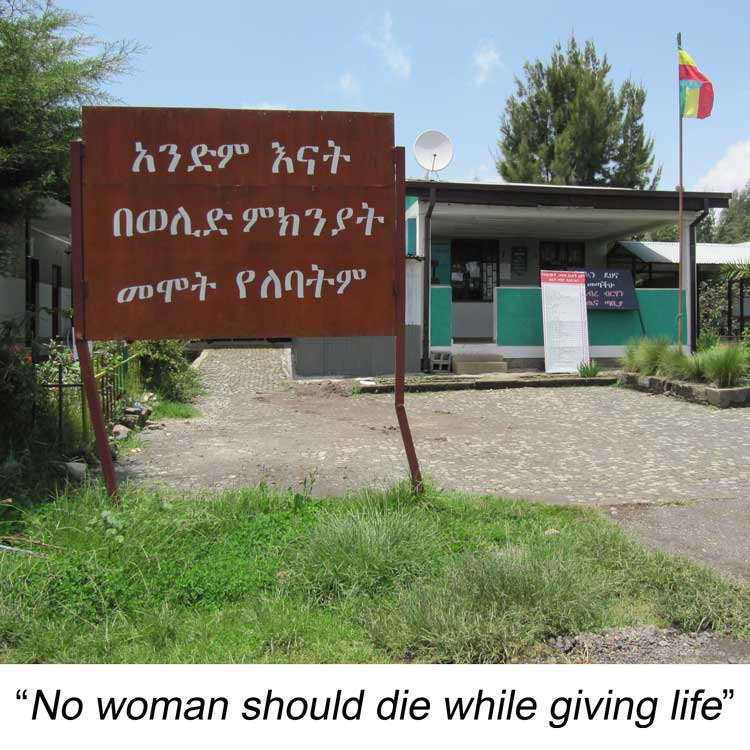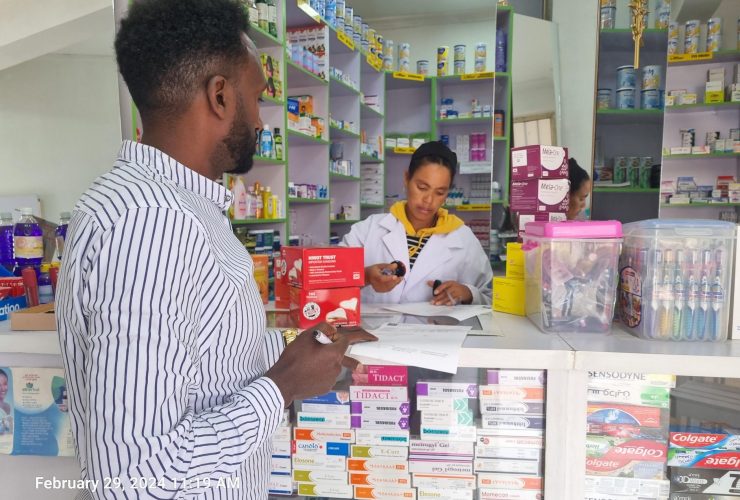Safe abortion – what does it mean in the Ethiopian context?
Women’s healthcare providers in Ethiopia can often encapsulate the effects of unsafe abortion in a few words. The septic room. The ward at Black Lion.
They easily recall stories of women injured or lost from a self-induced abortion. A trail of blood on the clinic floor. A beautiful woman dying shortly after arrival at care.
Most can also speculate how the absence of safe abortion services, legalized in 2005, would lead to harmful consequences for women in the country.
BackgroundUnsafe abortion is defined by the World Health Organization (WHO) as, “a procedure for terminating a pregnancy performed by persons lacking the necessary skills or in an environment not in conformity with minimal medical standards, or both”[1]. Safe abortion, it stands to reason, must be performed by a capable person in a medically conducive environment. |
 |
In 2005, the Ethiopian Government amended the country’s Penal Code to expand instances in which a woman could legally obtain an abortion . Prior to this time, abortion was only allowed in cases, “done to save the pregnant woman from grave and permanent danger to life or health, which it is impossible to avert in any other way”.
This determination had to be made by two physicians, “qualified as specialist[s] in the alleged defect of health from which the pregnant woman [was] suffering”, compounding the risk to pregnant women in a country that had just one physician for every 50,000 Ethiopians in 2000[2].
At the time Ethiopia amended its Penal Code, the country’s maternal mortality rate (MMR) was 743 per 100,000 live births, among the highest in the world, though decreasing thanks to the introduction and uptake of modern contraceptives and expanding healthcare infrastructure. It was estimated that abortion-related complications accounted for 32% of all maternal deaths in 2005[3]. The cost of care associated with abortion was also suggested to be “enormous”[3].

Source: World Health Organization et al[4]
Abortion today
Ethiopia has shown considerable success in decreasing abortion-related mortality. In 2014, abortion accounted for 6-9% of maternal mortality, a roughly three-quarters reduction from 2005[5].
According to the Federal Ministry of Health, an estimated 420,000 induced abortions occurred in 2016 out of 4.2 million pregnancies1. A 2014 study put this figure at 620,300 (2014)[6], giving an annual abortion rate of 28 per 1,000 women aged 15–49[6]. Another study of university students from Wolaita in 2010 showed a higher abortion rate at 65 per 1,000 women[7].
Access to basic abortion care services has expanded greatly in recent years. In 2014, access to basic abortion services was available at 117% of the recommended level of facilities compared to 25% in 2008[8]. Still, an estimated 294,100 abortions occurred outside of health facilities in 2014[6]. A revision to the Technical and Procedural Guideline for Safe Abortion Services in Ethiopia in 2014 expanding abortion service to Lower Clinics should help to reduce this figure.
The multi-decade increase in modern contraception Ethiopia has experienced is helping to limit the rate of abortion in the country. The 2016 Ethiopian Demographic and Health Survey showed a modern contraceptive prevalence rate (CPR) of 35%, up from 27% in 2011. In comparison to post abortion care (PAC), modern contraception is extremely cost effective, equating to just 3–12% of the average cost of treating one post-abortion client[9]. New options like post-partum intra-uterine contraceptives (PPIUD) will also be helpful.
Adolescents
Adolescents are of particular concern. A study of 829 women at health facilities in Jimma showed that more than half (55.6%) of second-trimester abortions were received by women less than 19 years of age[10]. Another study of second trimester abortions at referral hospitals in Amhara showed that 24% of women were between the ages of 15 – 19 years old[11]. Because second trimester abortions disproportionately contribute to maternal morbidity and mortality, especially in low-resource countries, this is particularly concerning[11].

One of the risks to teenage girls facing pregnancy is suicide[12]. Self-harm was the second leading cause of death globally among girls aged 10 – 19 years, claiming approximately 32,000 lives in 2015, and teenage pregnancy was shown to be a risk factor for suicide in a study in South Africa[13].
“Health providers readily cite suicide as one of the ways clients would deal with unwanted pregnancy if MA and MVA were not available in Ethiopia,” says Fitih Tola, DKT Ethiopia’s Public Relations Officer.
“For many girls and women, the social and economic barriers would be overwhelming.”
Post-abortion family planning
Post-abortion family planning is an excellent opportunity to increase contraceptive uptake and prevent repeat abortion. A 2016 study showed that 86% of women in Ethiopia accepted contraception following an abortion, one of the highest rates of the eight developing countries considered in the study[14].
An intervention in Southern Nations, Nationalities and Peoples (SNNP) Region that integrated CAC and comprehensive contraceptive trainings as well as providing other technical and quality improvements increased the proportion of abortion clients who accepted contraception from 58% to 83% over a five year period[15].
Notes
1. Internal Federal Ministry of Health quantification document
References
1. Ganatra B, Tunçalp Ö, Johnston B, Jr RJ, Gülmezoglu M. From concept to measurement : operationalizing WHO’s definition of unsafe abortion. 2014.
2. World Health Organization. Success Factors for Women’s and Children’s Health Ethiopia. Geneva, Switzerland; 2015.
3. Federal Ministry of Health [Ethiopia]. Technical and Procedural Guidelines for Safe Abortion Services in Ethiopia. 2006.
4. WHO, UNICEF, UNFPA, World Bank Group, United Nations Population Division. Maternal Mortality in 1990-2015: Ethiopia.; 2015.
5. Federal Ministry of Health [Ethiopia]. Technical and Procedural Guidelines for Safe Abortion Services in Ethiopia Second Edition.; 2014. 6. Moore AM, Gebrehiwot Y, Fetters T, et al. The Estimated Incidence of Induced Abortion in Ethiopia, 2014: Changes in the Provision of Services Since 2008. Int Perspect Sex Reprod Heal Heal. 2016;42(3):111-120. doi:10.1363/42e1816.The.
7. Gelaye AA, Taye KN, Mekonen T. Magnitude and risk factors of abortion among regular female students in Wolaita Sodo. BMC Womens Health. 2014;14(1):1-9. doi:10.1186/1472-6874-14-50.
8. Dibaba Y, Dijkerman S, Fetters T, et al. A decade of progress providing safe abortion services in Ethiopia : results of national assessments in 2008 and 2014. 2017:1-12. doi:10.1186/s12884-017-1266-z.
9. Vlassoff M, Singh S, Onda T, Lane M, York N. The cost of post-abortion care in developing countries : a comparative analysis of four studies. 2016;(April):1020-1030. doi:10.1093/heapol/czw032.
10. Bonnen KI, Tuijje DN, Rasch V. Determinants of first and second trimester induced abortion – results from a cross-sectional study taken place 7 years after abortion law revisions in Ethiopia. 2014:1-9. doi:10.1186/s12884-014-0416-9.
11. Mulat A, Bayu H, Mellie H, Alemu A. Induced Second Trimester Abortion and Associated Factors in Amhara Region Referral Hospitals. 2015;2015. doi:10.1155/2015/256534.
12. Chan L, Mohamad Adam B, KN N, et al. Suicidal ideation among single, pregnant adolescents: The role of sexual and religious knowledge, attitudes and practices. J Adolesc. 2016;Oct:162-169. doi:10.1016/j.adolescence.2016.08.006.
13. Shilubane HN, Ruiter RAC, Bos AER, Reddy PS, Borne B Van Den. High school students’ knowledge and experience with a peer who committed or attempted suicide : a focus group study. BMC Public Health. 2014:1-9. http://www.biomedcentral.com/1471-2458/14/1081.
14. Benson J, Andersen K, Brahmi D, et al. What contraception do women use after abortion ? An analysis of 319 , 385 cases from eight countries. Glob Public Health. 2016;0(0):1-16. doi:10.1080/17441692.2016.1174280.
15. Samuel M, Fetters T, Desta D. Strengthening Postabortion Family Planning Services in Ethiopia : Expanding Contraceptive Choice and Improving Access to Long-Acting Reversible Contraception. Glob Heal Sci Pract. 2016;4:60-72.




